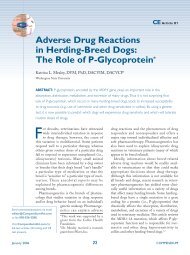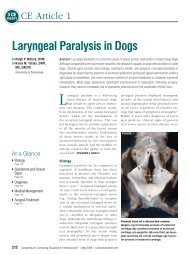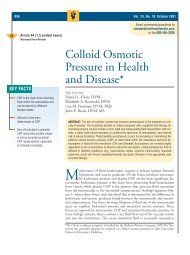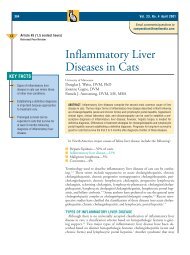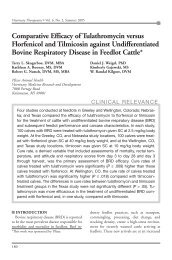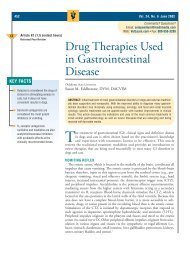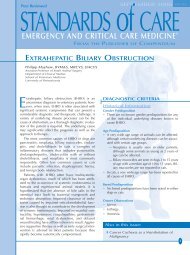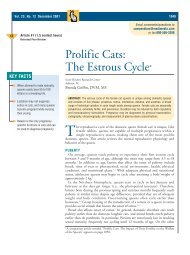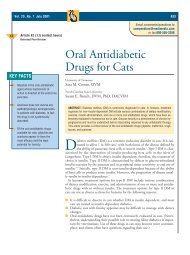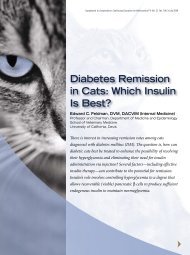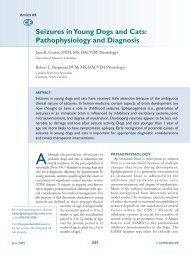Wall-July PV-Review - VetLearn.com
Wall-July PV-Review - VetLearn.com
Wall-July PV-Review - VetLearn.com
- TAGS
- cp.vetlearn.com
Create successful ePaper yourself
Turn your PDF publications into a flip-book with our unique Google optimized e-Paper software.
618 Small Animal/Exotics Compendium August 2002<br />
Lameness<br />
Lameness due to IE is an occasional finding rarely<br />
caused by septic emboli but usually the result of<br />
immune-mediated arthritis. 3,4,6,9,35,36,39 Synovial tissue<br />
may contain IgG, IgM, and <strong>com</strong>plement, indicating an<br />
immune basis for the arthropathy. 35,36<br />
Organ Failure<br />
Dogs with IE may present with signs consistent with<br />
CHF (usually left-sided), including coughing, dyspnea,<br />
pulmonary crackles (pulmonary edema), shortness of<br />
breath, weakness, and/or collapse. 3,6 CHF is most frequently<br />
associated with aortic valve IE. When the left<br />
heart appears radiographically normal in size, but pulmonary<br />
edema is present, IE should be considered<br />
because dramatic heart enlargement may not yet have<br />
occurred in the case of acute IE. The index of suspicion<br />
of IE rises in dogs that have no history of a heart murmur<br />
or are not prone to cardiomyopathy or myxomatous<br />
valvular degeneration. 6<br />
Renal failure is another <strong>com</strong>plication that may<br />
detract from recognizing IE. Renal failure is usually<br />
due to chronic infarction or glomerulonephritis<br />
(Figure 2). 3,6,13,37,38<br />
Polysystemic Signs<br />
The constitutional signs of IE can mimic those of<br />
any polysystemic disease. 3,6 Many diagnostic differentials<br />
must be considered, including immune-mediated<br />
diseases, rickettsial infections, bacteremia alone, sequelae<br />
of neoplasia, causes of CHF, and causes of renal failure.<br />
2,6,12,13,33,35,36 Localized signs, such as lameness,<br />
edema, and pain, often arise from <strong>com</strong>plications of<br />
Figure 2—Gross pathology kidney specimen from a dog with<br />
aortic valve IE. The kidney has been sectioned in the sagittal<br />
plane. Multiple triangular-shaped, pale infarctions of variable<br />
age are visible within the renal parenchyma.<br />
www.<strong>VetLearn</strong>.<strong>com</strong><br />
infection. 6,35,36,39 In order to avoid overlooking IE, the<br />
possibility should be investigated when one or more of<br />
the following signs are present:<br />
• An unexplained fever<br />
• A heart murmur of recent onset<br />
• A source of infection<br />
• Embolic phenomena<br />
Systemic Embolization<br />
IE always results in embolization. The kidneys consistently<br />
exhibit old and new infarcts that contribute to<br />
proteinuria and renal failure. The spleen, liver, and<br />
iliac or mesenteric arteries are sometimes involved.<br />
Splenic septic abscesses may contribute to persistent<br />
fever and leukocytosis.<br />
CLINICAL PATHOLOGY<br />
Hematologic findings of systemic inflammation are<br />
often absent in IE. This may be due to antibiotic or<br />
steroid administration or chronic, low-grade bacteremia.<br />
6,12 Although an inflammatory leukogram is not<br />
always present, monocytosis is present in 90% of<br />
cases. 6,12 In some instances, mature neutrophilia and<br />
monocytosis indicate low-grade, chronic inflammation.<br />
Thrombocytopenia is another <strong>com</strong>mon finding and<br />
can be attributed to systemic vasculitis and immune or<br />
coagulatory consumption. 6,12<br />
A variety of serum biochemical abnormalities may<br />
be observed. A septic triad may be present, characterized<br />
by low or decreasing albumin, increased serum<br />
alkaline phosphatase activity, and absolute or relative<br />
hypoglycemia. 6,13 Hypoalbuminemia may be explained<br />
by proteinuria, anorexia, or decreased liver function<br />
caused by toxins. 6,13 Increased serum alkaline phosphatase<br />
activity is usually due to toxin interference<br />
with bile metabolism or prior steroid use. 6,13,14 Hypoglycemia<br />
can be explained by bacterial toxin effects on<br />
intermediary metabolism. 13,14 Azotemia may be prerenal<br />
or caused by infarction and glomerulopathy. 3,9,10,37,38<br />
The urine often contains protein, blood, casts, and/or<br />
bacteria. 6,13 Urine culture is re<strong>com</strong>mended not only<br />
because bacteria are filtered from the blood into the<br />
urine but also because the urinary tract may be a<br />
source of infection. 6,13<br />
SPECIAL DIAGNOSTICS<br />
The diagnosis of IE requires integration of clinical<br />
and laboratory findings. Arrhythmias (usually atrial or<br />
ventricular premature contractions) are present in at<br />
least 50% to 75% of documented cases; seldom life<br />
threatening; and best evaluated by long-term, continuous<br />
electrocardiographic monitoring (either cage-side



